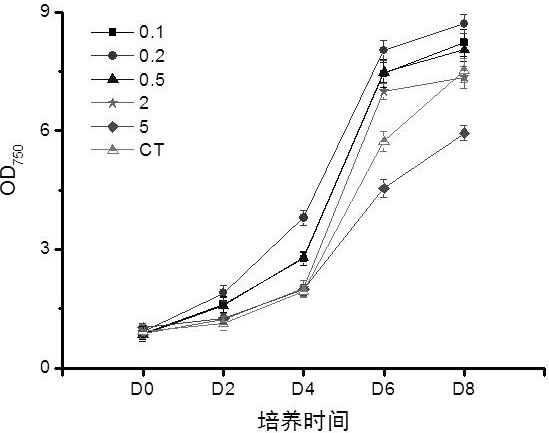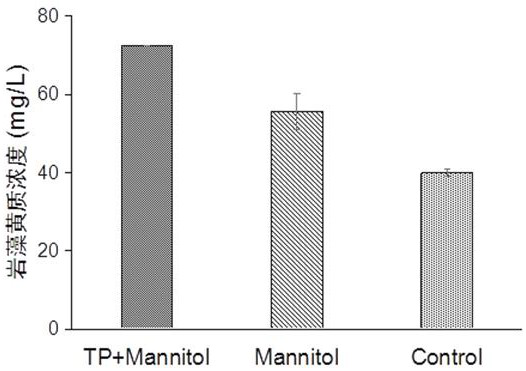A concurrent culture method for producing polyunsaturated fatty acids and fucoxanthin by using Phaeodactylum tricornutum
A technology of unsaturated fatty acid and fucoxanthin, applied in the field of bioengineering
- Summary
- Abstract
- Description
- Claims
- Application Information
AI Technical Summary
Problems solved by technology
Method used
Image
Examples
Embodiment 1
[0072] Embodiment 1 Mannitol concentration experiment
[0073] The method for concurrently cultivating Phaeodactylum tricornutum to produce polyunsaturated fatty acids and fucoxanthin, the steps are as follows:
[0074] (1) Cultivate Phaeodactylum tricornutum to logarithmic growth phase (temperature 24°C, 80 μmol photons m −2 ·s −1 cultivated under light conditions for 3 days) to obtain seed solution;
[0075] (2) Inoculate the seed solution prepared in step (1) into the culture medium at a volume ratio of 5-50%, and inoculate at a temperature of 23-25°C and 100 μmol photons·m −2 ·s −1 Cultivate under light conditions for 10 days, and the photoperiod is 16h light and 8h dark;
[0076] For the culture medium in the step (2), prepare the culture medium whose carbon source is 0.5, 1, 2, 4, 10 and 15 g / L of mannitol, and take no mannitol as the control, the above medium The other ingredients are as follows per liter:
[0077] 1 g NaNO 3 , 30 g sea salt, 4.37 mg Na 2 EDTA, ...
Embodiment 2
[0079] Embodiment 2 tea polyphenols concentration experiment
[0080] The method for concurrently cultivating Phaeodactylum tricornutum to produce polyunsaturated fatty acids and fucoxanthin, the steps are as follows:
[0081] (1) Cultivate Phaeodactylum tricornutum to logarithmic growth phase (temperature 24°C, 80 μmol photons m −2 ·s −1 cultivated under light conditions for 3 days) to obtain seed solution;
[0082] (2) Inoculate the seed solution prepared in step (1) into the culture medium at a volume ratio of 5-50%, and inoculate −2 ·s −1 Cultured under light conditions for 8 days, with a photoperiod of 16 h light and 8 h dark;
[0083] For the culture medium in the step (2), prepare medium containing tea polyphenols at a concentration of 0.05, 0.1, 0.2, 0.5, 1.0, 2.0 and 5.0 g / L respectively, and without adding tea polyphenols as a control, the above culture The content per liter based on other ingredients is as follows:
[0084] 2 g mannitol, 1 g NaNO 3 , 30 g sea...
Embodiment 3
[0087] As in the method described in Example 1, the difference is that the contents of each liter of medium components are as follows:
[0088]2 g mannitol, 0.2 g / L tea polyphenols, 10 g NaNO 3 , 10g sea salt, 10 mg Na 2 EDTA, 1 mg FeCl 3 •6H 2 O, 12 mg NaH 2 PO 4 •12H 2 O, 10 mg Na 2 SiO 3 •7H 2 O, 0.1 mg CuSO 4 • 5H 2 O, 0.002 mg MgSO 4 •7H 2 O, 0.1 mg CoCl 2 •6H 2 O, 0.02 mg MnCl 2 • 4H 2 O, 0.01 mg Na 2 MoO 4 • 2H 2 O, 0.0001 mg biotin.
PUM
 Login to View More
Login to View More Abstract
Description
Claims
Application Information
 Login to View More
Login to View More - R&D
- Intellectual Property
- Life Sciences
- Materials
- Tech Scout
- Unparalleled Data Quality
- Higher Quality Content
- 60% Fewer Hallucinations
Browse by: Latest US Patents, China's latest patents, Technical Efficacy Thesaurus, Application Domain, Technology Topic, Popular Technical Reports.
© 2025 PatSnap. All rights reserved.Legal|Privacy policy|Modern Slavery Act Transparency Statement|Sitemap|About US| Contact US: help@patsnap.com



